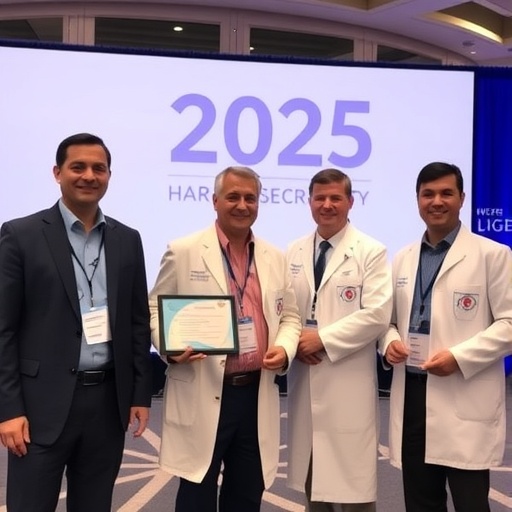In recent years, the landscape of early childhood development has undergone a profound transformation owing to technological advancements, particularly in the realm of healthcare. One of the most significant shifts has been the integration of tele-assessment strategies for evaluating developmental concerns in toddlers. The study conducted by Parikh, Ni, Gangi, and their colleagues’ sheds light on this innovative approach by capturing caregivers’ perspectives on tele-assessment. This groundbreaking research, set to be published in the Journal of Autism and Developmental Disorders, highlights the ongoing revolution in how we perceive child assessment and intervention.
The onset of the COVID-19 pandemic acted as a catalyst for the proliferation of telemedicine across various fields—including pediatrics and developmental disorders. Tele-assessment, which utilizes digital communication tools to conduct evaluations and assessments for developmental delays or disabilities, gained traction as in-person visits became challenging. This change is not merely a reaction to an unprecedented global health crisis but reflects a broader trend towards the digitization of healthcare services. For caregivers, this transition has offered both opportunities and challenges in managing their children’s developmental assessments from the comfort of their homes.
Caregivers are often the first to spot developmental concerns in their toddlers, yet accessing timely and effective assessment services can be a daunting task. The traditional approach typically involves multiple appointments, extensive waiting periods, and geographical limitations that can be particularly burdensome for families. The shift to tele-assessment seeks to alleviate some of these stressors by streamlining the assessment process through digital platforms. This method enables caregivers to engage with healthcare professionals without the logistical concerns that accompany traveling to clinics or hospitals.
According to the findings of Parikh et al., caregivers reported a mixed bag of experiences with tele-assessment. While many appreciated the convenience and flexibility it offered, some voiced concerns about the effectiveness of remote assessments compared to in-person evaluations. This discrepancy underscores an essential dialogue within the healthcare community regarding the balance between leveraging technology for efficiency and ensuring that assessments remain thorough and comprehensive. The caregivers’ insights are invaluable for perfecting these virtual interactions, enabling professionals to tailor approaches to meet families’ varied needs effectively.
The modernization brought by tele-assessment gives rise to the potential for expanded access to healthcare resources. For families residing in rural or underserved urban areas, internet-based assessments create the possibility of connecting with specialists who might otherwise be inaccessible. This democratization of access can lead to earlier identification and intervention of developmental disorders, which is critical as research consistently shows that early intervention can significantly improve long-term outcomes for children. Caregivers who have experienced these advantages often highlight newfound hope and empowerment in navigating their child’s developmental journey.
Despite its benefits, the study also highlights key barriers that need to be addressed for tele-assessment to be a viable long-term solution. Technological literacy stands out as a significant factor, as not all caregivers are equally comfortable with virtual platforms. Inadequate internet connectivity remains another formidable challenge, particularly in low-income households. For tele-assessment to reach its full potential, these systemic issues must be acknowledged, and strategies developed to bridge these gaps, ensuring equitable access to this innovative assessment method for all families.
Moreover, the study reflects on how the relationship dynamics between caregivers and healthcare professionals have shifted with tele-assessment. The virtual interaction often presents a different dynamic than in-person assessments, where body language and environmental cues play a significant role in communication. While video calls enable face-to-face interaction, the nuances of physical presence can sometimes be lost, affecting the assessment process. Healthcare professionals adapting to this burgeoning mode of interaction face the challenge of maintaining rapport and trust in a digital environment, which can influence the overall quality of assessments.
Another crucial aspect illuminated in the research is the need for training for both caregivers and healthcare providers. To optimize remote assessments, caregivers require knowledge not just of the technologies involved, but also of the expectations and processes associated with tele-assessment. Similarly, healthcare professionals need to be equipped with the skills to conduct effective assessments in a virtual space. This training will be integral to enhancing the reliability and efficacy of tele-assessment methodologies, ultimately leading to better developmental outcomes for children.
As we further explore the implications of tele-assessment for toddlers with developmental concerns, it is important to keep an eye on comprehensive approaches that include regular feedback from caregivers. Caregivers are adept at providing insights on their children’s behaviors and developmental milestones; thus, their active participation in the assessment process is crucial. Encouraging caregivers to share their experiences can foster a collaborative environment that benefits both the assessment process and the family’s overall engagement with healthcare resources.
The implementation of tele-assessment is only part of a larger conversation about the future of pediatric evaluation and intervention. As technology advances, the healthcare community must continue to evolve its practices. This includes exploring how specific tools and applications can optimize assessments and deliver tailored interventions based on the diverse needs of families. The key lies not only in embracing technology but also in ensuring that these advancements translate into tangible benefits for children and their caregivers.
Ultimately, the study conducted by Parikh, Ni, and Gangi offers a significant contribution to understanding the caregiver perspectives on tele-assessment for toddlers with developmental concerns. By shedding light on both the advantages and limitations of this approach, it paves the way for more informed discussions within the healthcare community. As tele-assessment continues to gain traction, the need for ongoing research will be pivotal in shaping best practices and ensuring that technological innovations meet the fundamental goal of enhancing child development outcomes.
The potential impact of tele-assessment on developmental evaluations represents a fascinating frontier in pediatric healthcare. The marriage of healthcare and technology marks a defining moment in our approach to child development, indicative of how systematic changes can improve access, streamline processes, and empower families. As caregivers begin to navigate this new terrain, their voices will be instrumental in guiding future research directions and clinical practices.
In summarizing the findings of this significant study, it’s clear that while tele-assessment presents exciting opportunities for redefining how we approach developmental evaluations, ongoing efforts are needed to ensure that these methods are accessible, effective, and responsive to the needs of children and their families. As we stand at this juncture, the work of researchers like Parikh and his colleagues contributes to a hopeful and transformative path forward in pediatric developmental health.
Subject of Research: Tele-assessment for toddlers with developmental concerns from a caregiver perspective.
Article Title: Caregiver Perspectives on the Use of Tele-Assessment for Toddlers with Developmental Concerns.
Article References:
Parikh, C., Ni, R., Gangi, D. et al. Caregiver Perspectives on the Use of Tele-Assessment for Toddlers with Developmental Concerns.
J Autism Dev Disord (2025). https://doi.org/10.1007/s10803-025-07016-2
Image Credits: AI Generated
DOI: 10.1007/s10803-025-07016-2
Keywords: Tele-assessment, toddlers, developmental concerns, caregiver perspectives, early intervention, technology in healthcare.
Tags: advantages of remote child assessmentcaregiver perspectives on telemedicinechallenges of tele-assessment for caregiversCOVID-19 impact on pediatric assessmentsdevelopmental concerns in early childhooddigital healthcare innovationsearly intervention strategies for toddlersevaluating developmental delays remotelyintegrating telehealth into pediatric caretechnological advancements in healthcaretele-assessment strategies for toddlerstelemedicine in developmental disorders





